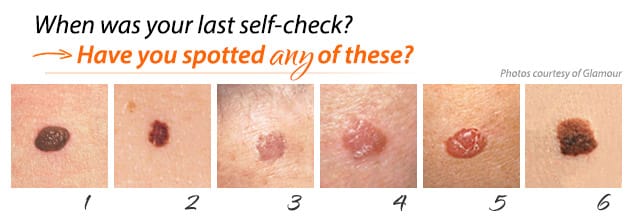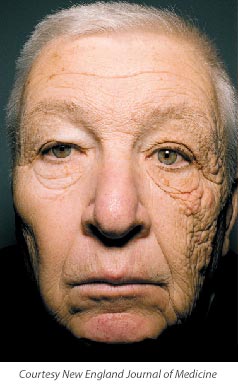Skin Cancer rates continue to climb – despite increased warnings. In the past few decades, the incidence of melanoma has risen 800 percent among women ages 18-39. Take measures to protect your skin daily, and perform regular skin checks to aid in early detection. Glamour magazine has published this self-check for seven years, and 84 readers were able to identify their own skin cancer or that of a loved one and sought treatment. We hope Rejuvent patients will do the same!
1- Normal Mole:
A small brown spot that’s symmetrical and all one shade and that hasn’t changed over the years is probably nothing to worry about.
2- Dysplastic Nevus:
AKA an “atypical mole”. This tends to be dark with irregular borders. It could become cancerous, so your doctor will remove it or keep a close eye on it.
3- Actinic Keratosis:
This potentially cancerous spot usually occurs on sun-exposed areas (scalp, lips, hands) and tends to look like a raised, rough, or scaly patch.
4- Squamous Cell Carcinoma:
Look for a reddish patch or wart-like bump that may crust or bleed. Get it checked out ASAP – left untreated, it may spread.
5- Basal Cell Carcinoma:
The most common type of skin cancer, BCC forms deep in the skin and looks like a raised pink growth or a sore that won’t heal.
6- Melanoma:
This dangerous cancer has an irregular shape with blurred borders and tends to be dark brown or black in color, but it can also be multicolored.
Please visit your dermatologist if you are concerned about any skin lesions. Annual full-body skin exams by a dermatologist are recommended for adults.
Sunscreen Q & A
How many times a day should I apply sunscreen?
Applying sunscreen in the morning will not protect you all day at the beach – or even daily errands. Your SPF will protect you during the short times you need to be in the sun; it’s not meant to allow you to stand in the line of fire all day. Reapply SPF 30 or higher every 60-80 minutes to protect yourself – and wear a hat!
What type of sunscreen should I buy? There are so many on the market!
Look for these words: water-resistant, broad-spectrum, and an SPF of 30 or higher. A sunscreen must block both UVA and UVB to be effective.
For your body, we recommend Revision Multi-Protection Broad Spectrum SPF50, and for your face, try Jan Marini Antioxidant Daily Face Protectant SPF 33. It doesn’t have that “sunblock-y” smell and is also available in three tinted versions to even skin tone while providing broad-spectrum sun protection.
Do I really need to wear SPF when it’s cloudy and I’m at work?
Yes! UV rays can pass through both windows and clouds.
This image should motivate you to wear SPF in car!
This man is 69 years old, but half of his face looks much, much older than that. He was a trucker and, for 28 years, his face received much more sunlight on the left side, resulting on premature aging. We all know that being exposed to the sun makes you age prematurely, but seeing the dramatic difference in a single face is just stunning. His condition is called unilateral dermatoheliosis, from the Greek dermis (skin) and helios (sun). It’s also called photoaging, and it results from chronic exposure to the sun’s UVA and UVB rays. In his case, it only affected the left side of his face because of his work. As he drove, he received more hours of sunlight through the left window of his vehicle.
I wear foundation with SPF every day. Is that enough?
No. Most foundations contain SPF 15 (not 30+!), and to get the SPF printed on the label, a thick, mask-like layer would need to be applied. We recommend following your daily skin care regimen with your sunscreen, let products soak in for ten minutes, then apply makeup as usual.


